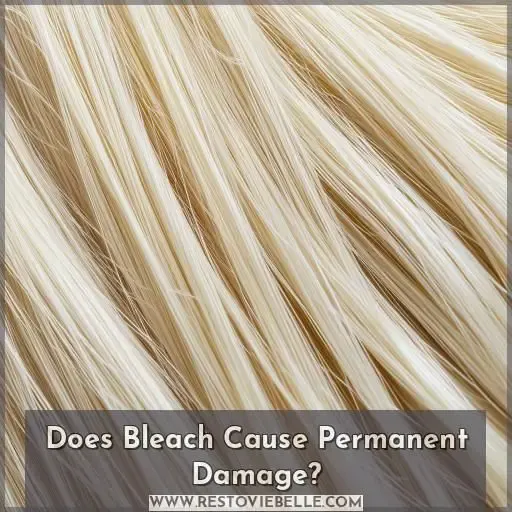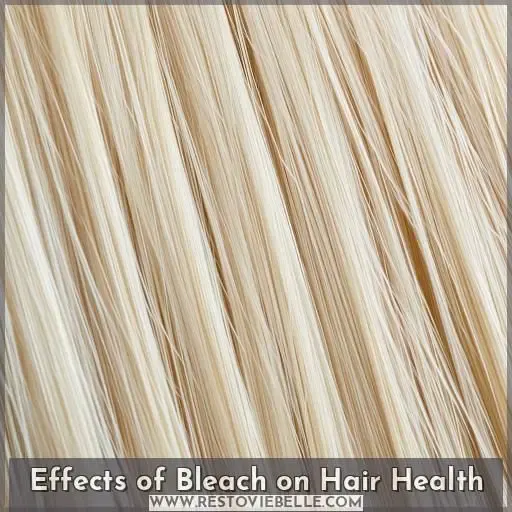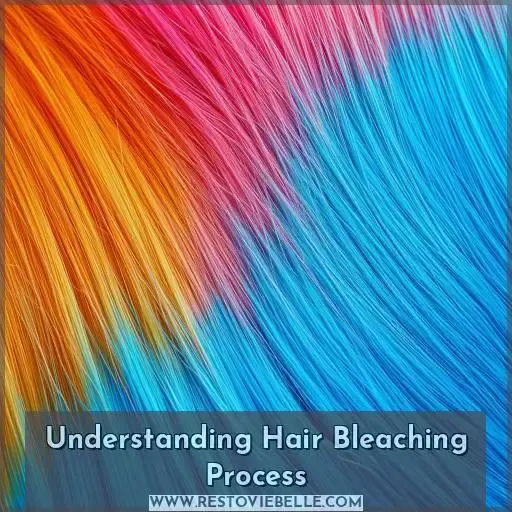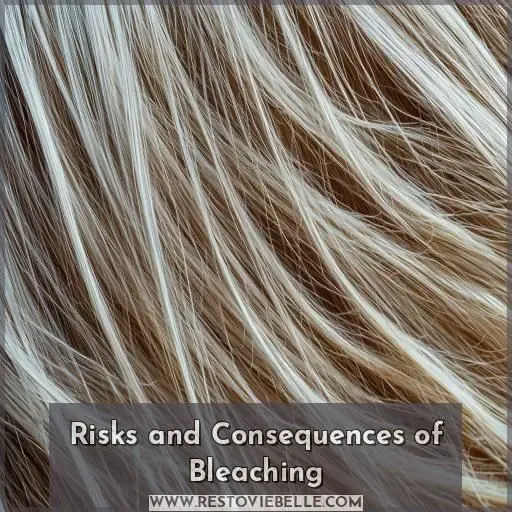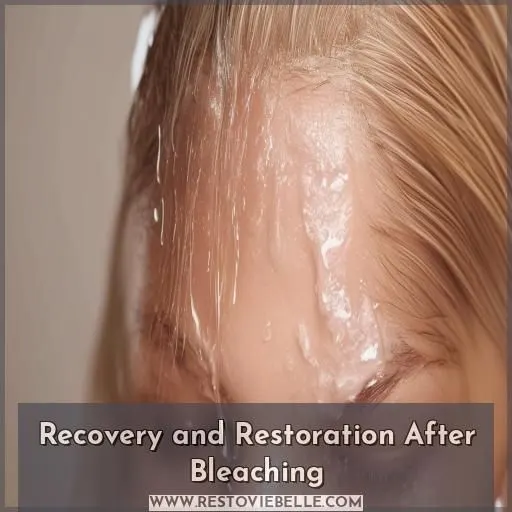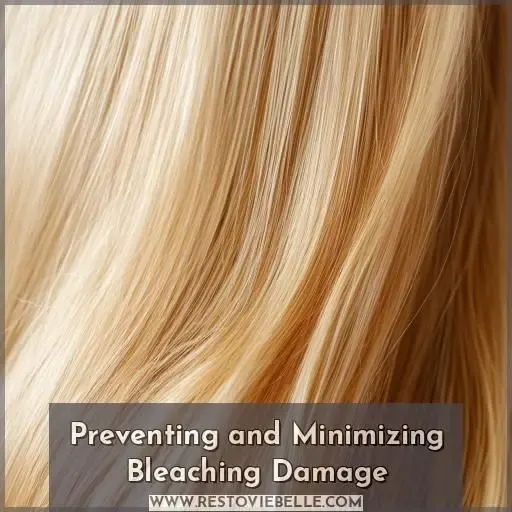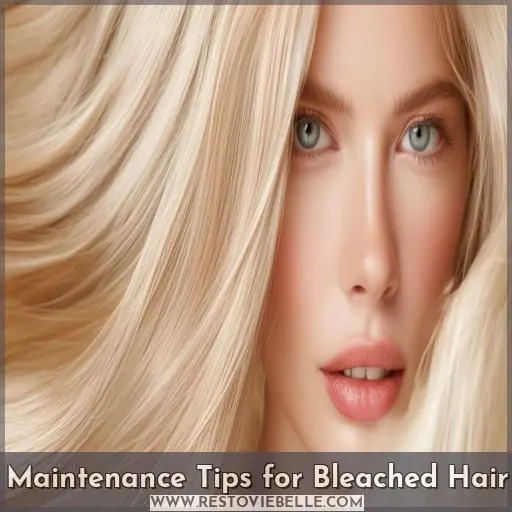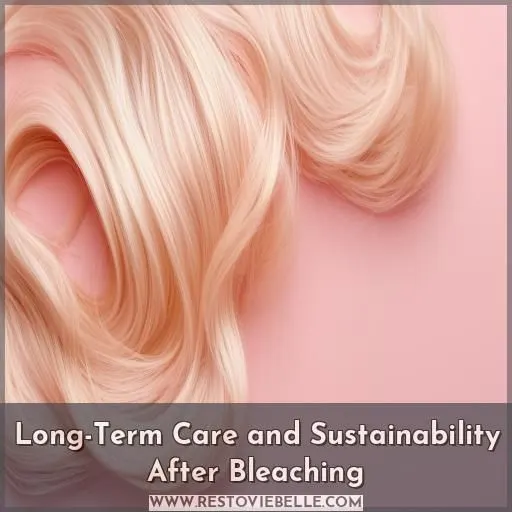This site is supported by our readers. We may earn a commission, at no cost to you, if you purchase through links.
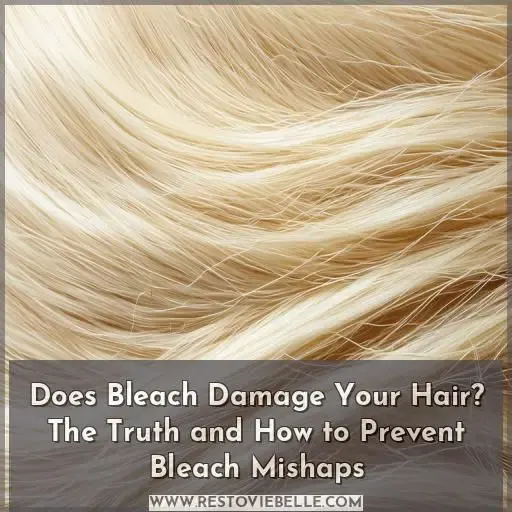
Expect texture changes, dryness, frizz, and breakage after bleaching.
But don’t fret – proper care can minimize the impact. Use nourishing masks, conditioners, and strengthening treatments to fortify strands.
And remember, a little damage is often worth achieving your desired blonde bombshell look!
Keep reading to learn smart tips for recovering from and preventing bleach mishaps.
Table Of Contents
- Key Takeaways
- Does Bleach Damage Your Hair?
- Does Bleach Cause Permanent Damage?
- Effects of Bleach on Hair Health
- Understanding Hair Bleaching Process
- Risks and Consequences of Bleaching
- Recovery and Restoration After Bleaching
- Preventing and Minimizing Bleaching Damage
- Maintenance Tips for Bleached Hair
- Long-Term Care and Sustainability After Bleaching
- Frequently Asked Questions (FAQs)
- Is bleached hair damaged forever?
- Can you bleach your hair and it still be healthy?
- How damaging is it to bleach your hair?
- Does bleached hair grow back healthy?
- How long does it take for bleached hair to grow out?
- Can bleached hair be dyed back to its natural color?
- Does bleaching cause permanent hair loss or thinning?
- How often can you bleach your hair without damage?
- Can bleached hair be permed or chemically straightened?
- Conclusion
Key Takeaways
- Buckle up, buttercup! Bleaching is basically a chemical assault on your tresses, stripping away their natural protective layers and proteins. Expect some serious texture changes, dryness, frizz, and breakage after the bleach party.
- But fear not, hair warriors! With a little TLC and some nourishing masks, conditioners, and strengthening treatments, you can fortify those strands and minimize the bleach-induced damage. It’s all about restoring that moisture and bounce.
- Remember, a little damage is often the price we pay for achieving that coveted golden goddess look. Embrace the drama, darling! Just don’t go overboard and give your locks a breather between bleaching sessions.
- At the end of the day, bleached hair can still be healthy hair with the right care routine. Treat those tresses like royalty, and they’ll thank you with luscious, vibrant locks that turn heads wherever you go.
Does Bleach Damage Your Hair?
Yes, bleach can damage your hair by altering hair texture and causing protein band breakage (Source). To prevent damage, use nourishing products and adopt a hair care routine focused on restoration (Source).
Does Bleach Cause Permanent Damage?
Bleaching your hair can cause permanent damage if misused.
The chemicals in hair bleach, like hydrogen peroxide and ammonia, open your hair cuticles to remove pigment. But this process also strips away your hair’s natural oils and proteins, leaving it dry, brittle, and prone to breakage .
Home bleaching kits may seem tempting, but they require precise mixing and application to avoid scalp burns or hair bleach poisoning.
For the healthiest results, always consult a professional stylist. They have the expertise to lighten your hair while minimizing damage .
With proper precautions and aftercare, bleached hair can look fabulous without sacrificing its health.
Effects of Bleach on Hair Health
You’ll notice a significant change in your hair’s texture after bleaching – it may feel drier, rougher, and more brittle. This occurs because the bleaching process opens up the hair cuticles and breaks down some of the protein bonds that give your hair its structure and strength.
Changes in Hair Texture
Bleaching can greatly alter your hair’s texture, leaving it drier, thicker, and frizzier. This is because the bleaching process breaks down the hair’s natural proteins, causing it to swell and become more porous. To maintain your hair’s health after bleaching, use nourishing products, avoid heat styling, and deep condition regularly. Embrace your new texture and wear it with confidence!
- Bleaching breaks down hair proteins
- Hair becomes drier and thicker
- Frizz is common after bleaching
- Use nourishing products to restore health
Impact on Hair Cuticles
Bleach opens the hair cuticle, leading to cuticle damage and affecting hair health.
This damage alters the hair’s natural structure, impacting the overall appearance and texture of the hair.
To maintain healthy cuticles post-bleaching, it’s essential to focus on cuticle repair, protection, and restoration.
Implementing a routine that includes nourishing and protective products can aid in maintaining the health and integrity of the hair cuticles.
Protein Band Breakage
Bleaching leads to protein band breakage, causing structural damage and hair weakness, compromising the integrity of keratin in your hair strands. This can result in visible and tactile changes, such as increased dryness, frizziness, and a reduction in hair strength. To illustrate, imagine the brittleness of a dry leaf. Fortunately, diligent care and the right products can help restore the health of your bleached hair.
- Fragile Strands
- Brittle Texture
- Susceptibility to Breakage
Understanding Hair Bleaching Process
Now that you understand how bleach affects your hair’s health, let’s explore the hair bleaching process itself.
Bleaching employs a combination of lightening techniques and color removal methods to gradually elevate your natural hair color.
Before bleaching, it’s imperative to properly prepare your hair by utilizing nourishing products that fortify and safeguard your strands.
The actual bleaching process entails applying a mixture of bleach powder and developer to your hair, which opens up your cuticles and oxidizes the melanin pigment, causing it to dissolve and lighten your color.
After bleaching, it’s necessary to preserve your hair’s health with post-bleaching care routines endorsed by your hair stylist.
Understanding this process is key to minimizing bleach-related damage and attaining your desired hair color.
Risks and Consequences of Bleaching
While bleaching can dramatically transform your hair color, it’s essential to be aware of the potential risks and consequences.
Bleach opens your hair cuticle and oxidizes melanin, causing lightening. However, this process can also break 15-20% of your hair’s protein bands, leading to dryness, frizziness, and even breakage (Source).
The length and frequency of bleaching sessions, your natural hair color, and hair type all influence the level of damage .
Scalp irritation is another common side effect .
To minimize risks, avoid bleaching if your hair is already damaged and wait at least 14 days between sessions .
Use nourishing hair masks and maintain a healthy hair care routine to support your strands .
Recovery and Restoration After Bleaching
The telltale signs of bleaching damage include excessive hair breakage, frizziness, dryness, slowed growth, and scalp irritation. Several factors influence the extent of damage, such as your natural hair color, the duration and frequency of bleaching sessions, your hair type, and your overall hair care routine.
Signs of Bleaching Damage
Bleached hair can show signs of damage like breakage, dryness, and frizziness. Your scalp may feel irritated, and hair growth may slow down. To restore your locks, use nourishing hair masks, leave-in conditioners, and strengthening products. Chelating treatments can help remove buildup. With the right hair care routine, you can repair bleach damage and keep your hair healthy.
| Damage Sign | Description |
|---|---|
| Hair Breakage | Strands snap easily |
| Hair Dryness | Parched, brittle texture |
| Scalp Irritation | Itchiness, redness |
| Slowed Growth | Sluggish new growth |
| Frizziness | Unruly, unmanageable hair |
Factors Influencing Damage
The frequency of bleaching and your hair’s condition before treatment are key factors influencing damage. Bleach less often, ideally every 8-10 weeks, and avoid over-processing. Make sure your hair is healthy before bleaching by using nourishing products. Factors like hair type, length, and porosity also impact damage. Protect your hair with moisturizing treatments and limit heat styling to minimize bleaching mishaps.
- Bleach less frequently, every 8-10 weeks
- Make sure healthy hair before bleaching
- Protect hair with moisturizing treatments
Preventing and Minimizing Bleaching Damage
To prevent and minimize bleaching damage, you’ll want to use nourishing and protective products that replenish moisture and repair the hair’s structure. Restoring your hair’s health with bond-building and strengthening treatments can help rebuild those broken protein bonds and revive your locks after the harsh bleaching process.
Nourishing and Protective Products
To prevent excessive damage from bleaching, use nourishing products like deep conditioners and hair masks to plump strands with moisture. Protective sprays and serums shield bleached hair from heat, environmental stressors, and moisture loss. Gently detangle with a wide-tooth comb, avoid pulling, and let hair air dry when possible. Regular chelating treatments remove product buildup and restore hair’s natural shine.
Restoring Hair Health and Structure
To restore your hair’s health and structure after bleaching, use targeted products like bond-building treatments, protein masks, and deep conditioners. These nourishing formulas help repair damage, strengthen strands, and replenish moisture for softer, smoother, and more manageable hair. Pair with gentle cleansing and styling to minimize further breakage and keep your bleached locks looking their best .
Maintenance Tips for Bleached Hair
To maintain the health and vibrancy of your bleached hair, you’ll want to incorporate nourishing hair masks and leave-in conditioners into your routine. Additionally, using strengthening treatments and chelating products can help fortify strands weakened by the bleaching process.
Use of Hair Masks and Conditioners
To keep your bleached hair healthy, use a nourishing hair mask once a week and a leave-in conditioner daily. Deep conditioning treatments are essential for restoring moisture and strength. Experiment with different hydrating options to find what works best for your hair type. Regular use of protein repair treatments can also help rebuild damaged strands.
Strengthening and Chelating Products
Strengthen your bleached hair with bond repair treatments that reconnect broken bonds and protect against future damage. Deep condition weekly to replenish moisture and boost shine. Use chelating shampoos to remove product buildup and hard water deposits that can dull color. Avoid heat styling when possible to prevent further weakening of strands.
Long-Term Care and Sustainability After Bleaching
When it pertains to the long-term care and sustainability of bleached hair, it’s imperative to concentrate on repair, upkeep, and protective measures. Safeguarding the well-being of your hair includes utilizing nourishing products, embracing sustainable practices, and mending the hair’s inherent structure. Here are a few suggestions to manage the long-term health and sustainability of bleached hair:
- Utilize nourishing hair masks and leave-in conditioners to replenish moisture and strength.
- Incorporate strengthening products and chelating treatments to sustain overall hair health and shield against further damage.
- Consider sustainable practices in your hair care routine, such as the use of gentle care, bond repair, and deep conditioning to uphold the long-term health and sustainability of your hair.
These strategies will assist in restoring and maintaining the health of bleached hair, promoting long-term repair and sustainable practices.
Frequently Asked Questions (FAQs)
Is bleached hair damaged forever?
In days of yore, bleached hair was doomed. Not anymore! With proper care and nourishing products, your lightened locks can thrive. The key is consistent conditioning and repairing treatments to restore strength and health.
Can you bleach your hair and it still be healthy?
Yes, with proper care, your bleached hair can stay healthy. Use bond-repairing treatments, deep conditioners, and heat protectants. Be gentle when detangling, and give your strands plenty of nourishment.
How damaging is it to bleach your hair?
Bleaching chemically alters your hair’s structure, causing damage. The more sessions, the greater the damage – from dryness and breakage to scalp irritation. Proper preparation and aftercare are essential in minimizing harm.
Does bleached hair grow back healthy?
Yes, bleached hair can grow back healthy if you treat it gently. Use deep conditioning and bond repair products to nourish and strengthen your locks during the regrowth process.
How long does it take for bleached hair to grow out?
Oh, the agonizing wait to grow out bleached hair! Brace yourself, it takes roughly 6-12 months for those vibrant locks to return fully to their natural hue. But with proper TLC, you’ll rock that fresh growth in no time!
Can bleached hair be dyed back to its natural color?
Yes, you can! With the right products and approach, you can restore your bleached hair to its natural color. Start with a color-depositing shampoo or at-home dye kit formulated for damaged, porous hair.
Does bleaching cause permanent hair loss or thinning?
No, bleaching doesn’t permanently thin hair or lead to lasting hair loss. However, it can temporarily make strands more fragile and prone to breakage if not properly cared for afterward.
How often can you bleach your hair without damage?
Envision your sun-kissed strands after bleaching: brittle, limp—a shadow of their former glory. To avoid this heartbreak, limit bleaching sessions to once every 6-8 weeks max. Let your locks recover between chemical assaults.
Can bleached hair be permed or chemically straightened?
You can chemically straighten or perm bleached hair, but it’s riskier. The chemicals further damage already-weakened strands, so proceed cautiously.
Conclusion
Ultimately, bleach does damage your hair, stripping away essential proteins and protective layers. Proper pampering and protection provides paramount prevention – nourishing masks, conditioners, and strengthening treatments fortify fragile follicles. With wise, watchful care, you can cultivate alluring color while minimizing mishaps. Remember, a little damage is often worthwhile to achieve your desired dazzling hue.

